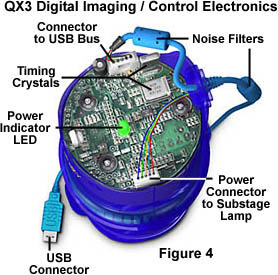Intel Play Qx3 Microscope Windows 7


Intel Play & Digital Blue USB Digital Microscopes (About, Software, Download Drivers & User Manuals). Covering the Intel Play QX3 & Digital Blue QX5 / QX7 models . Intel Play toys. Intel Play line of educational toys from 1999 to 2002. 4 Find your Intel Play QX3 Microscope device in the list and press double click on the image device. Click Reinstall driver button. 5 Choose Install from the specific location and click on the Browse button. Click on the Next and Finish button after that to complete the installation process.
There is some good news. The unit works with Linux. I fired up an Ubuntu Live CD and verified that it works. Unfortunately I can't use a Hyper-V VM and Ubuntu because USB passthrough only works with Windows Server 2012 and Windows 8 guest operating systems.:/ So that sucks.
I'll try to get it working in Windows instead. How hard could it be to write a USB device driver? It's simple Algebra. Negative - I haven't programmed in C since puberty.

Negative - I've never written a Windows driver before. Negative x Negative = I'm POSITIVE I can do this. This is the perfect combination of hubris and obsession for this to be an awesome project. So I got the chip specifications and developer's guide from this page: Ironically, that is where the Linux developers parked their stuff when they wrote this driver for Linux.
Next up I read the developer documentation on the slashdot site and started slogging through the writing a driver documentation on MSDN. I also grabbed a copy of '.
Intel Play Qx3 Computer Microscope
That's a link to Amazon, but I actually read it on Safari. It's a little light bedtime reading.
One of the first steps is choosing a driver model:. From the chip documentation I learned that I need one control endpoint and one isosynchronous endpoint. That narrows down my choices significantly.
I had hoped to make it work with the baked-in Windows USB Video Driver module by writing an extension to usbvideo.sys but that won't work. The camera either supports that or it doesn't. The remaining options are writing a Kernel Mode Driver (hard) or using the generic WinUSB driver and building all of the intelligence into the application. For now I've chosen the latter, as it is a much simpler solution. The unfortunate bit is that this driver will only work in Windows 8.1.
It is the only OS that supports isosynchronous data transfers with winusb. Fast forward 48 hours. I've installed Visual Studio 2013, Update 3, and the Windows Driver Framework for Windows 8. (This takes forever.:D )(Seriously, you can take a nap.) I used the Visual Studio WinUSB template to kick out the.inf for the driver and a stub application. This MSDN tutorial is incredibly helpful:. Yesterday I got a stub application working which can identify when the device is plugged in and read the firmware version from it. Today I moved all of the device specific code into its own class and started cranking out all of the functions needed to make to work.
Intel Play Qx3
It's just after midnight and I have 70% of the API written for the Control Channel. With any luck I'll get the isosynchronous endpoint communication working tomorrow and get some data to play with. My plan is to release the source code, driver, and completed application as open source. This is awesome! Useful things I've learned so far. Windows 8.1 will not permit you to install an unsigned driver by default.
The workaround is to reboot with 'shutdown -r -o -f -t 15' and select the advanced mode that will allow you to install the driver. The security of the sprintf command has been tightened down significantly. I had to switch to using sprintfs to get past a fatal compiler warning. Time for bed before I become more hallucinogenic/delusional from sleep deprivation.